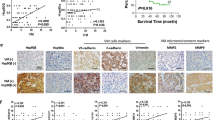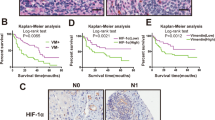Abstract
Objective
To explore possibility of vasculogenic mimicry (VM) in hepatocellular carcinoma (HCC) by constructing tumor cell three-dimensional culture system and liver cancer tissues.
Methods
Based on three-dimensional cell culture system developed by matrigel, liver cancer cell lines HepG2 were tested for evidence of VM. Fifteen HCC simples were collected. Potential formation of tumor channels and their characterization of network were observed by immunohistochemical and histological double staining of CD31 and PAS, or Ferritin and PAS.
Results
Three-dimensional culture model of HCC cell line proved the liver cancer cells stretch out thin and long tubers at the second day, and the cells linked each other to form wreath and network structure at the seventh day. In fifteen HCC simples, endothelial cells were all stained by CD31, and tumor cells were all stained by Ferritin. The immunohistochemical and histological double staining also exhibited evidence of VM in seven simples of HCC, CD31-negative and Ferritin-positive tumor cells were observed to form tubal structure. Tumor cells were separated by PAS-positive matter like basement membrane from the tube. Red blood cells could be seen in the tube. In well-differentiated simples, VM was less than that in poorly differentiated ones, and several CD31-positive tumor cells could be observed in poorly differentiated simples.
Conclusion
HepG2 cells have the capacity of self-metamorphose and vascularized trend. The tumor cells can obtain oxygen and nutrition through this structure.
Similar content being viewed by others
References
Folberg R, Hendrix MJ, Maniotis AJ. Vasculogenic mimicry and tumor angiogenesis. Am J Pathol, 2000, 156: 361–381.
Sun BC, Zhang SW, Zhao XL, et al. Study on vasculogenic mimicry in malignant melanoma. Chin J Pathol (Chinese), 2003, 32: 539–543.
Warren BA, Shubik P. The growth of the blood supply to melanoma transplants in the hamster cheek pouch. Lab Invest, 1966, 15: 464–478.
Maniotis AJ, Folberg R, Hess A, et al. Vascular channel formation by human melanoma cells in vivo and in vitro: vasculogenic mimicry. Am J Pathol, 1999, 155: 739–752.
Hoffmeyer MR, Wall KM, Dharmawardhane SF. In vitro analysis of the invasive phenotype of SUM 149, an inflammatory breast cancer cell line. Cancer Cell Int, 2005, 5: 11.
Sood AK, Fletcher MS, Coffin JE, et al. Functional role of matrix metalloproteinases in ovarian tumor cell plasticity. Am J Obstet Gynecol, 2004, 190: 899–909.
Sharma N, Seftor RE, Seftor EA, et al. Prostatic tumor cell plasticity involves cooperative interactions of distinct phenotypic subpopulations: role in vasculogenic mimicry. Prostate, 2002, 50: 189–201.
Yue WY, Chen ZP. Does vasculogenic mimicry exist in astrocytoma? J Histochem Cytochem, 2005, 53: 997–1002.
Cai XS, Jia YW, Mei J, et al. Tumor blood vessels formation in osteosarcoma: vasculogenesis mimicry. Chin Med J, 2004, 117: 94–98.
Sun BC, Zhang SW, Zhao XL, et al. Pilot study of molecular mechanism on vasculogenic mimicry in bi-directional differentiated malignant tumors. Chinese-German J Clin Oncol, 2005, 4: 50–52.
Xia H, Li GS, Li JJ, et al. Experimental study of formation of vascular tube in three-dimensional cell culture. Chin J Microcir (Chinese), 2000, 10: 5–7.
Zhang LJ, Zhang ZS, Zhang LF. Effect of basic fibroblast growth factor on formation of vascular tube in three-dimensional cell culture. Med J Wuhan Univ (Chinese), 2004, 25: 638–641.
Seftor RE, Seftor EA, Koshikawa N, et al. Cooperative interactions of laminin 5 gamma2 chain, matrix metalloproteinase-2, and membrane type-1-matrix/metalloproteinase are required for mimicry of embryonic vasculogenesis by aggressive melanoma. Cancer Res, 2001, 61: 6322–6327.
Author information
Authors and Affiliations
Corresponding author
Rights and permissions
About this article
Cite this article
Zhao, J., Wang, C., Yang, A. et al. Vasculogenic mimicry formation in hepatocellular carcinoma. Chin. -Ger. J. Clin. Oncol. 7, 530–533 (2008). https://doi.org/10.1007/s10330-007-0101-9
Received:
Revised:
Accepted:
Published:
Issue Date:
DOI: https://doi.org/10.1007/s10330-007-0101-9




